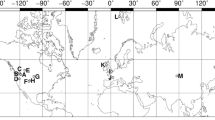Abstract
A new genus is recognized based on winged fruits with a single species shared between the Miocene of southwestern Honshu, Japan, and the Miocene of Oregon and Idaho, USA. Calyces of Ozakia emryi gen. et sp. n. were formerly attributed to Heptacodium (Caprifoliaceae) and Amelanchier (Rosaceae); however, newly recovered specimens reveal additional characters that contradict these assignments. The pedicellate fruits are obovate, tapering basally and truncate apically, with about 10 longitudinal ribs, a prominent epigynous synsepalous calyx of five lobes, each with a midvein and a pair of weaker, ascending intramarginal primary veins. The single style has a capitate stigma. Ozakia is considered to represent an extinct eudicot genus, the familial affinities of which remain uncertain. The eastern Asian–western North American disjunction of Ozakia occurrences suggests that this plant traversed the Beringia land bridge during or prior to the Middle Miocene. Relatively few extinct angiosperm genera are known as late as the Miocene.


Similar content being viewed by others
References
Axelrod DI (1998) The Oligocene Haynes Creek flora of Eastern Idaho. Univ Calif Publ Geol Sci 143:1–99
Crane PR (1987) Abelia-like fruits from the Palaeogene of Scotland and North America. Tertiary Res 9:21–30
Fields PF (1996) The Succor Creek flora of the Middle Miocene Sucker Creek Formation, southwestern Idaho and eastern Oregon: systematics and palaeoecology. PhD dissertation, Michigan State University
Graham A (1963) Systematic revision of the Sucker Creek and Trout Creek Miocene floras of southeastern Oregon. Amer J Bot 50:921–936
Graham A (1965) The Sucker Creek and Trout Creek Miocene floras of southeastern Oregon. Kent State Univ Bull 53:1–147
MacGinitie HD (1933) The Trout Creek flora of southeastern Oregon. Carnegie Inst Washington Pub 416:21–68, pl. 3–16
Manchester SR (1999) Biogeographical relationships of North American Tertiary floras. Ann Missouri Botl Gard 86:472–522
Manchester SR, Donoghue M (1995) Winged fruits of Linnaeeae (Caprifoliaceae) in the Tertiary of western North America: Diplodipelta gen. nov. Int J Plant Sci 156:709–722
Manchester SR, Crane PR, Dilcher DL (1991) Nordenskioldia and Trochodendron (Trochodendraceae) from the Miocene of northwestern North America. Bot Gaz 152:357–368
Ozaki K (1980) Late Miocene Tatsumitoge flora of Tottori Prefecture, Southwest Honshu, Japan (III). Sci Rep Yokohama Nat Univ Sec 2, 27:19–45, pl. 1–9
Ozaki K (1981) On the paleoenvironments of the Late Miocene Tatsumitoge flora. Sci Rep Yokoyama Nat Univ Sec 2(28):47–75
Pigg KB, DeVore ML (2005) Shirleya grahamae gen. et sp. nov. (Lythraceae), Lagerstroemia-like fruits from the middle Miocene Yakima Canyon flora, central Washington State, USA. Amer J Bot 92:242–251
Smiley CJ, Huggins LM (1981) Pseudofagus idahoensis, n. gen. et sp. (Fagaceae) from the Miocene Clarkia flora of Idaho. Am J Bot 68:741–761
Tanai T, Onoe T (1961) A Mio-Pliocene flora from the Ningyo-toge area on the border between Tottori and Okayama prefectures, Japan. Geol Surv Japan, Rep no 187, p 1–62, pl 1–18
Tiffney BH, Manchester SR (2001) The use of geological and paleontological evidence in evaluating plant phylogeographic hypotheses in the Northern Hemisphere Tertiary. Int J Plant Sci 162:S3–S17
Wolfe JA, Tanai T (1980) The Miocene Seldovia Point flora from the Kenai group, Alaska. U S Geol Surv Prof Pap 1105(1–52):1–25
Acknowledgments
We thank Robert Rosé and Greg Retallack for contributing important specimens and data concerning the collections made from Moose Mountain, Howard and Darlene Emry for specimens from Sucker Creek, William C. Rember for the specimen from Emerald Creek, Allen Marquette for the specimen from Haynes Creek, and Diane Erwin for providing access to specimens at the University of California Museum of Paleontology. Hongshan Wang provided assistance with specimens cited from Florida Museum of Natural History. Walter S. Judd provided helpful advice concerning possible botanical affinities and Terry Lott assisted with the investigation of extant taxa for comparison. Patrick F. Fields and two anonymous reviewers provided helpful comments for improvement of the original manuscript.
Author information
Authors and Affiliations
Corresponding author
Rights and permissions
About this article
Cite this article
Manchester, S.R., Uemura, K. Ozakia, a new genus of winged fruit shared between the Miocene of Japan and western North America. J Plant Res 127, 187–192 (2014). https://doi.org/10.1007/s10265-013-0602-2
Received:
Accepted:
Published:
Issue Date:
DOI: https://doi.org/10.1007/s10265-013-0602-2




